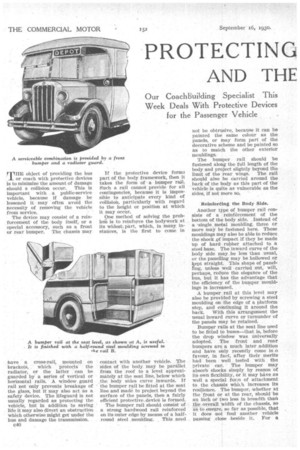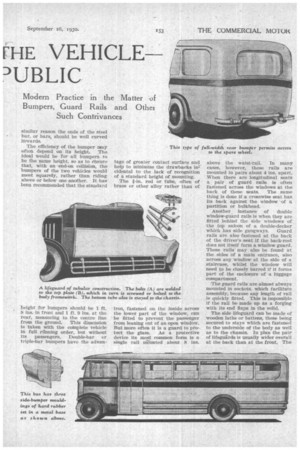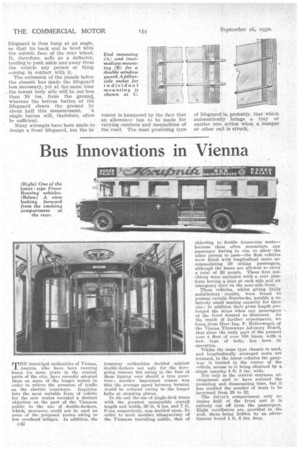PROTECTING
Page 62

Page 63

Page 64

If you've noticed an error in this article please click here to report it so we can fix it.
ME VEHICLE
AND THE
PUBLIC
Our Coachbuilding Specialist This Week Deals With Protective Devices for the Passenger Vehicle Modern Practice in the Matter of Bumpers, Guard Rails and Othel Such Contrivances
MITE object of providing the bus THE coach with protective deviCes is to minimize the amount of damage should a collision occur. This is important with a public-service vehicle, because if damage be lessened it may often avoid the necessity of removing the vehicle from service.
The device may consist of a reinforcement of the body itself, or a special accessory, such as a front or rear bumper. The chassis may
liave a cross-rail, mounted on brackets, which protects the radiator, or the latter can be guarded by a series of vertical or horizontal rails. A window guard rail not only prevents breakage of the glass, but it may also act as a safety device. The lifeguard is not usually regarded as protecting the vehicle, hut in addition to saving life it may also divert an obstruction which otherwise might get under the bus and damage the transmission, c40 If the protective device forms part of the body framework, then it takes the form of a bumper rail. Such a rail cannot provide for all contingencies, because it is impossible to anticipate every kind• of collision, particularly with regard to the height or position at which it may occur.
One method of solving the problem is to reinforce the bodywork at its widest, part, which, in many instances, is the first to come in • contact with another vehicle. The sides of the body may be parallel from the roof to a level approximately at the seat line, below which the body sides curve inwards. If the bumper rail be fitted at the seat line and made to project beyond the surface of the panels, then a fairly efficient protective ,device is formed. ' The bumper rail should consist of a strong hardwood rail reinforced on its outer edge by means of a halfround steel moulding. This need not be obtrusive, because it can be painted the same colour as the panels, or may form part of the decorative scheme and be painted so as to match the other exterior mouldings.
The bumper rail should be fastened along the full length of the body and project slightly beyond the limit of the rear wings. The rail should also be carried around the back of the body as this part of the vehicle is quite as vulnerable as the sides, if not more so.
Reinforeing the Body Side.
Another type of bumper rail consists of a reinforcement of the bottom of the body side. Instead of a 'single. metal moulding, three or more may be fastened here. These mouldings may also be able to reduce the shock _of impact if they be made up of hard rubber attached to a steel base. The inward curve of the body side may be less than usual, or the panelling may be hollowed or liept straight. This shape of panelhag, unless well carried out, will, perhaps, reduce the elegance of the bus, but it has the advantage that the efficiency of the bumper mouldings is increased.
A bumper rail at this level may also be provided by screwing a steel moulding on the edge of a platform step, and continuing it around the back. With this arrangenient the usual inward curve or turnunder of the panels may be retained.
Bumper rails at the seat line used to be fitted to buses—that is, before the drop window was Universally adopted. The front and rear bumpers are a much later addition and have only recently come in_o favour, in fact, after their .merits had been well tested with the private car. The bumper may absorb shocks simply by reason of its own flexibility, or it may have as well a special form of attachment to the chassis whith increases its resilience. The bumper, whether at the front or at the rear, should be an inch or two less in breadth than the overall width of the chassis, so as to ensure, so far as possible, that it does -not foul another vehicle PaSsing .close .beside it. For a
similar reason the ends of the steel bar, or bars, should be well curved inwards.
The efficiency of the bumper may often depend on its height. The ideal would be for all bumpers to be the same height, so as to ensure that, with an end-on collision, the bumpers of the two vehicles would meet squarely, rather than riding above or below one another. It has been recommended that the standard
height for bumpers should be 1 ft. 8 ins., in front and 1 ft. 9 ins, at the rear, measuring to the centre line from the ground. This dimension is taken with the colnplete vehicle in full raining order, but without its passengers. Double-bar or triple-bar bumpers have the advan
tage of greater contact surface and help to minimize the drawbacks in cidental to the lack of recognition of a standard height of mounting.
The I-in. rod or tube, often of brass or other alloy rather than of iron, fastened on the inside across the lower part of the window, can be fitted to prevent the passenger from leaning out of an open window. But mere often it is a guard to protect the glass. As a protective device its most common form is a single rail rallunted about 8 ins. above the waist-rail. In many cases, however, these rails are mounted in pairs about 4 ins. apart. When there are longitudinal seats a pair of guard rails is often fastened across the windows at the back of these seats. The same thing is done if a crosswise seat has its back against the window of a partition or bulkhead.
Another instance of double window-guard rails is when they are fitted behind the side windows of the top saloon of a double-decker which has side gangways. Guard rails are also fastened at the back of the driver's seat if the back-rest does not itself form a window guard. These rails may also be found at the sides of a main entrance, also across any window at the side of a staircase, whilst the window will need to be closely barred if it forms part of the enclosure of a luggage compartment.
The guard rails are almost always mounted in sockets, which facilitate assembly, because any length of rail is quickly fitted. This is impossible if the rail be made lip as a forging with its end flaps in the solid.
The side lifeguard can be made of wooden laths or battens, these being secured to stays which are fastened to the underside of the body as well as to the chassis. In plan the pair of lifegufirds is usually wider overall at the back than at the front. The lifeguard is thus bung at an angle, so that its back end is level with the outside face of the rear wheel. It, therefore, acts as a deflector, tending to push aside and away from the vehicle any person or thing coining in contact with it.
The extension of the panels below the chassis has made the lifeguard less necessary, yet at the same time the lowest body side will be notless than 10 ins, from the ground th., whereas the bottom batten of e lifeguard clears the -ground by about half this measurement. A single batten will, therefore, often be sufficient.
Many attempts have been made to design a front lifeguard, but the in
ventor is hampered by the fact that an allowance has to be made for varying cambers and inequalities of the. road. The most promising type
of lifeguard is, probably, that which automatically brings • a tray or carrier irito action when a bumper or other rail is struck,












































































































